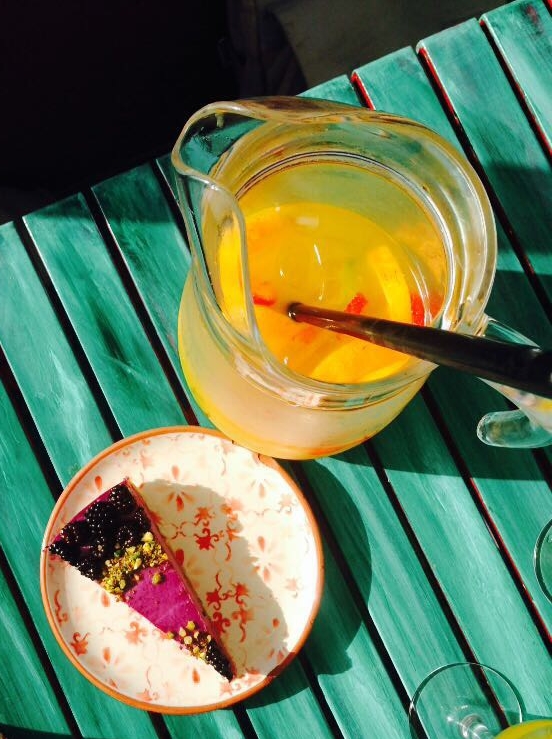
Sangria for a Spanish Summer (even if you’re across the pond)
Dear Alberto,
It might seem stereotypical, but sangria is one of those drinks that just calls your name in summer, especially if you are lucky enough to be abroad in Spain (or even luckier to call it your home). Maybe because it can be chilled over ice or because you can fill it with whatever fruit your heart desires, but many afternoons/evenings it seems more refreshing than a beer (which is also a good summer option—check out our top tips for ordering a beer here). However, there is more to sangria than meets the eye, so let’s dive in.
Keep in mind: My favorite sangria is homemade! So follow the tips below and soon you will be showing off your sangria-making skills for all your friends and family!
 A little history:
A little history:
While no one is really sure where sangria comes from, most people think that the name is related to the word sangre or blood in Spanish. However, we can also see a similar drink called “wine lemonade” (limonada de vino) in different countries in South America. Today sangria is recognised as being Spanish or Portuguese, to the point that within Europe only drinks made in these countries can be legally considered as real sangria (if made in Germany, for example, it would have to be labeled as “German-style sangria”).
At the same time, in Spain, a lot of restaurants and bars cater to tourist when they serve sangria and, because it takes a little bit more work to make, will sell it at a significantly higher price than other drinks on the menu. If it is good, it will be worth it, but if not, you are better off making your sangria at home—and it is not even that hard!
A head’s up: While traditionally sangria may pop into your head as a blood-red drink, it is important not to get caught up on the idea that sangria is only made with red wine! Some of my favorite sangrias have been made with a light white wine or cava (Catalan style champagne). So be open to trying these varieties as well while you are having a drink!
The ingredients:
Like when we talked about paella, with sangria, everyone will agree on the basics, in this case: wine, fruit chopped into small bits, and ice. From there, things get a little bit trickier. Starting with these main ingredients, you can swap out the traditional red wine for a white wine, a cava, etc. and you can use any type of fruit that strikes your fancy. If making sangria at home, pick out a bottle of wine or bubbles that you like (make sure it is nice, but it doesn’t have to be too nice) and think about what types of fruit you would like to add.
 For example, if I have a nice rioja (red) wine, I would probably consider adding apples, oranges, and melon. On the other hand, if I am using a dry cava, I might add blueberries, peaches, and strawberries. I always recommend buying what is fresh and going from there!
For example, if I have a nice rioja (red) wine, I would probably consider adding apples, oranges, and melon. On the other hand, if I am using a dry cava, I might add blueberries, peaches, and strawberries. I always recommend buying what is fresh and going from there!
After you have chosen the wine and fruit you have a couple of more choices to make. Firstly, you should decide if you want to add additional liqueur. If you decide that you do, again, think about what will go well with your wine choice when making this decision. With red wines, consider adding something like coñac, port, or Cointreau, and for white or champagne-style wines consider something more along the lines of Grand Marnier. Some recipes recommend marinating your chopped fruit in an additional liqueur with sugar over night, which can definitely give it that extra kick (just beware that your sangria may then be stronger than you realize).
The second thing you should consider is if you want to add a sparkling water or lightly flavored soda (Sprite, Seven Up, or the like). Adding in one of these options will make your drink lighter and cooler, especially on a hot day, in addition to allowing you to have a glass or two more that you probably would without it. You can also add a light cava to a wine-based sangria without loosing any of your alcohol potential!
For the finishing touches you can decide to add in a variety of spices (anything from warming spices such as cinnamon and clove to fresh herbs such as mint). These flavors will add a little something special to your drink and give it that extra touch of homemade.
Top tip: always make sure to try your sangria before serving it to others—this way you can always add a bit more of something you’ve let fall short. In addition, if it is too bitter or sour, consider adding in a spoon or two of sugar. Flavor is important, so make sure you enjoy responsibly!
 Celebrate or enjoy a quiet evening
Celebrate or enjoy a quiet evening
Whether or not you are making the recipe for your loving partner or for a party of your closest friends, make sure you enjoy the drink—consider it a celebration of Spanish summers and fresh fruits. The more you practice, the better you will get at making combinations that you like! Soon you will be able to whip up a batch of your favorite sangria in no time.
If you want my recommendation, serve it with a paella or tapas to get the whole Spanish experience!
Do you love sangria?! Let us know!
Sincerely,
Spain




